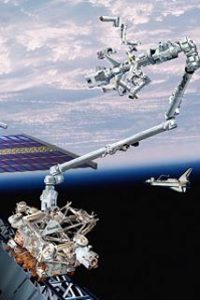STS-120 Delivers Node 2 “Harmony”
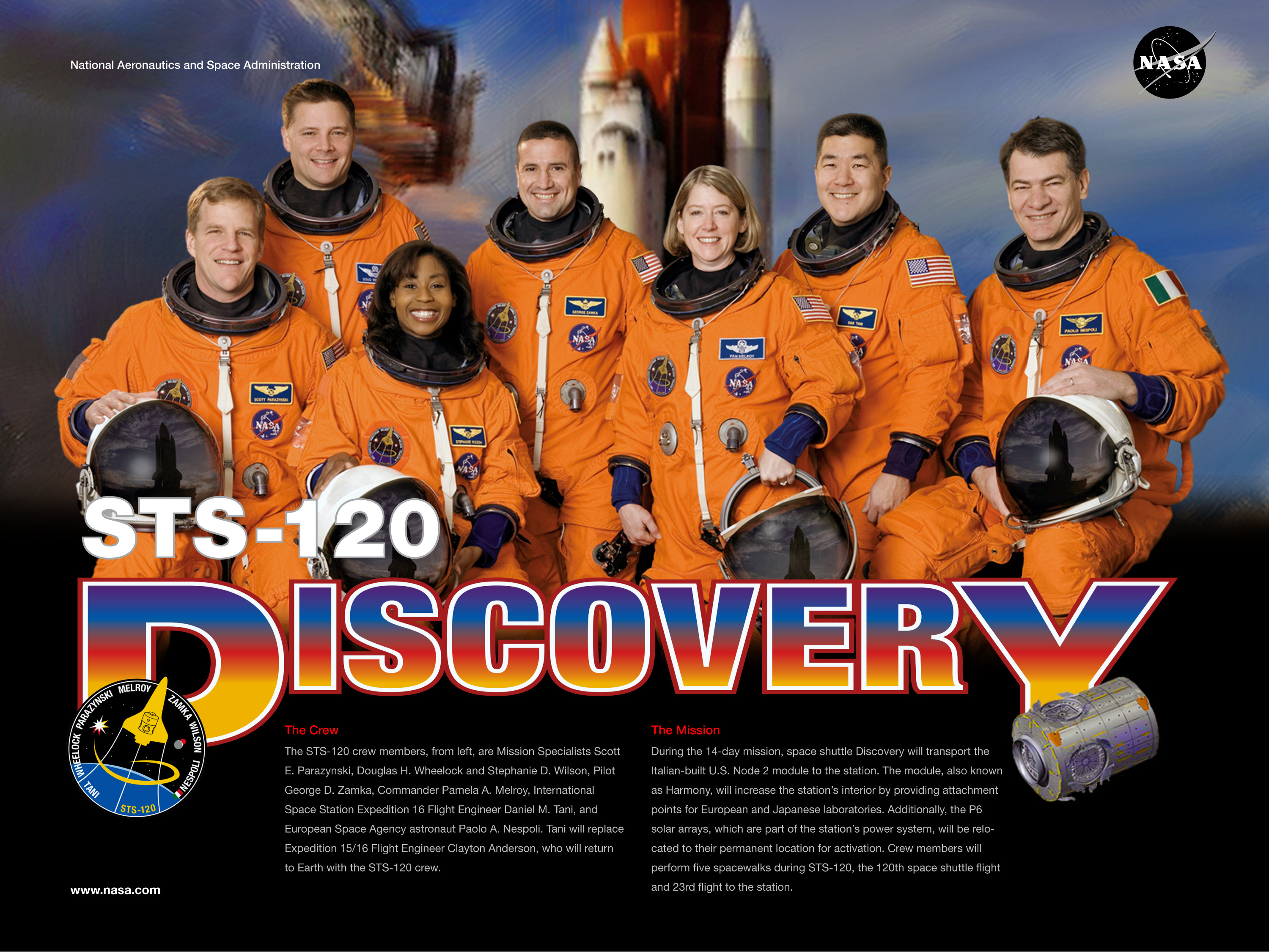

Discovery launched on October 23, 2007, in what Michael Leinbach called “One of the cleanest countdowns we’ve had since I’ve been a Launch Director.” Commanded by Pamela Melroy, the crew also included Pilot George Zamka, Mission Specialists Scott Parazynski, Douglas Wheelock, Stephanie Wilson, and the ESA’s Paolo Nespoli, and Expedition 16/17 crew member Daniel Tani. Clayton Anderson would be returning home with the Discovery. Discovery docked with the International Space Station on October 25.
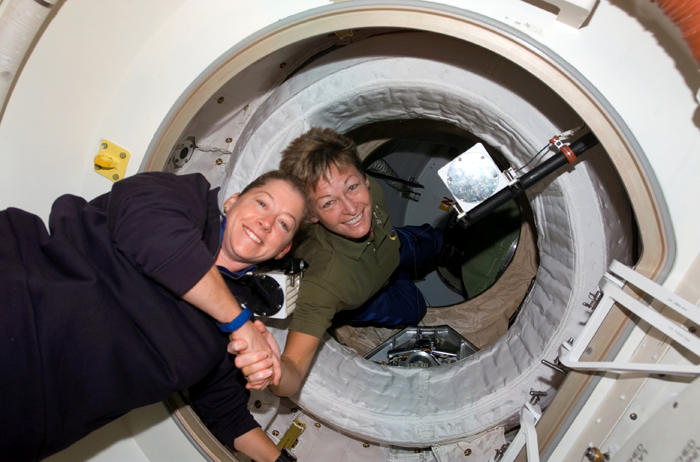
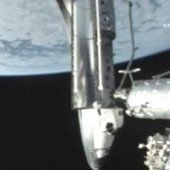
Mission Commander Pamela Melroy was enthusiastic about the moment that two female commanders would shake hands in space for the first time. “The most important thing to me is the picture we take when our hands first meet across the hatches,” she said of it in interviews. Peggy Whitson had shown considerably less enthusiasm about it but understood that it was important to Melroy and greeted her warmly when the hatches were opened. Whitson considered this moment a pure coincidence caused by delays in the launch schedule. In fact, her mind was already on all the work that needed to be done. STS-120 was a complex mission with five planned EVAs, the delivery of the “Harmony” module that would make future construction and expanded crews possible, and the move of the P6 Truss from its location on the Z1 Truss to the port end of the Integrated Truss Structure (ITS).
Initial duties included moving EVA equipment to Quest and moving Daniel Tani’s couch liner and Sokol pressure suit from Discovery to Soyuz TMA-11. Clayton Anderson moved his equipment to Discovery. Houston analyzed the pictures of Discovery‘s exterior that had been taken by the shuttle’s robotic arm and the Expedition 16 crew and informed the crew that the damage was negligible. “That is fantastic news,” Melroy responded.
In the meantime, preparations for the first EVA continued. On the morning of October 26, Douglas Wheelock and Scott Parazynski began their EVA a half hour early. Whitson kidded, “We’ll open the hatch so you guys can go out and play.” Parazynski was awestruck by the spectacular view of Earth from the open hatch. With Nespoli coordinating activities as the Intravehicular Officer, Wheelock and Parazynski retrieved a malfunctioning S-band antenna on the Z1 Truss for return to Earth and disconnected umbilicals in preparation for the move of the P6 Truss segment. Ammonia contamination was always a risk in this kind of operation and Parazynski was exposed to a mild leak. Wheelock happened to spot Houston while still working on the Z1 Truss. “Oh, boy, look at that.”
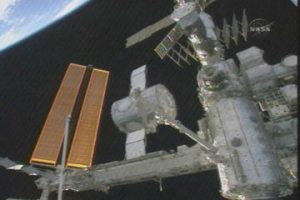
The two EVA astronauts proceeded to Discovery’s payload bay to mount a payload and data grapple fixture that would not have fit on Harmony while it was being delivered to the International Space Station. They disconnected umbilicals that supplied electricity and coolant. Then, Harmony was grasped by Canadarm2, which Peggy Whitson referred to as the “big arm” to the chagrin of the shuttle crew who had the “small arm”, and the “big arm” moved Harmony to its temporary post on Unity’s port CBM.
With their tasks completed, the two EVA astronauts returned to Quest. Because Parazynski had been exposed to ammonia, the Quest airlock was partially pressurized and then depressurized to jettison any ammonia that might have clung to him. Quest was pressurized and other crew members passed in wet towels so that the two astronauts could clean one another’s EMUs. Once this was done, the two astronauts bagged the towels and left Quest with an EVA of 6 hours 14 minutes.
The Solar Array Rotary Joint (SARJ) used to rotate the starboard Solar Array Wing had been showing signs of increased friction for the past six weeks. Ground controllers decided to lock it in a fixed position until the problem could be solved and added a visual inspection to the tasks for the second EVA.
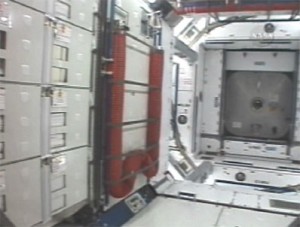
The next day, the combined crews opened Harmony for the first time. The plan was not to power it up fully since it was only in a temporary location, but rather to apply only minimal power and install a temporary ventilation line to provide air. Whitson and Nespoli were the first ones inside. They held a press conference inside Harmony. “This kicks off the international science portion of the Space Station’s life cycle,” Melroy said of it. She also admitted that being a Shuttle Commander could be somewhat dull while a Space Shuttle was actually docked: “I just sat around and made lunch for everyone and watched them do a totally fantastic job.”
Scott Parazynski and Daniel Tani handled the second EVA on December 28. While they prepared for the spacewalk, Wilson and Wheelock used Canadarm2 to grasp the P6 Truss. This EVA was going to take a complex choreography with two EVA astronauts and both Canadarm2 and the Shuttle’s RMS at work. Peggy Whitson called the entire operation of moving the P6 Truss the “sportiest” one of the mission. The work was going to be spread across three days, two EVAs and a lot of work with both robotic arms.
Parazynski and Tani made their way to the base of the P6 Truss and disconnected the final cables and bolts holding it to the Z1 Truss. Wilson and Wheelock lifted the truss segment away from Z1 and left it there. Meanwhile, Parazynski made his way to Harmony’s exterior, where he installed handrails for future EVAs. Tani proceeded to the Starboard side of the Integrated Truss, where he checked the CETA cart for sharp edges on the handrails. He went from their to the malfunctioning rotary joint, removed the covers and inspected the joint for anything that might be causing the friction. He discovered friction wear and tear along with a black dust that included metal shavings. While program managers decided what to do about the problem, use of the rotary joint would be limited.
Tani went on to reconfigure lines for the future deployment of an S1 cooling radiator, and then both EVA astronauts attached a Power Data Grapple Fixture to Harmony’s exterior and removed launch covers on Harmony. The EVA ended with a duration of 6 hours and 33 minutes.
The P6 Truss Segment was left on the end of Canadarm2 until the next day. While Parazynski and Wheelock made preparations for the third EVA, the combined crews teamed up with Wilson and Zamka working with Discovery’s “Little Arm” RMS and Anderson and Tani working with the International Space Station’s “Big Arm” Canadarm2. Canadarm2 handed off P6 to the RMS, and then rode the Mobile Transporter along the existing truss structure to the end of the Port ITS. The trip took an hour and a half.
While they waited, Whitson and Tani installed avionics racks within Harmony and the rest of the crew moved smaller items from Discovery to the space station. Mission controllers decided to extend the mission and postpone the fifth EVA by a day. Plans to inspect the Port Solar Array Rotary Joint on P6 were added to the third EVA to provide a point of comparison. The locked SARJ on the Starboard side meant a reduction of power, which could limit the usefulness of future modules slated to be sent to the International Space Station.
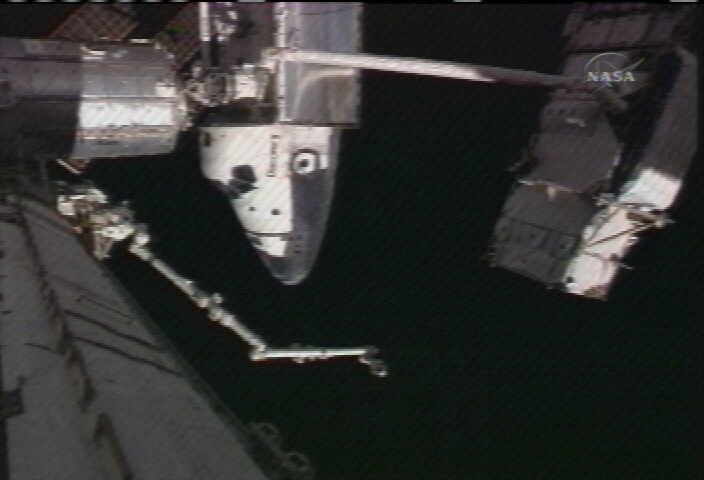
While ground controllers continued to debate the problem, Parazynski and Wheelock began their preparations for the third EVA on October 30. The Discovery’s RMS was positioned so that Canadarm2 had a chance of snagging it. Even from its position at the very end of the Mobile Transporter, the station’s “Big Arm” had to stretch to the limit to reach it. Half the station was powered down to prevent power from arcing from the station to the P6 power connectors while connections were made.
Parazynski and Wheelock exited through Quest and made their way to the end of the P5 ITS. While the two EVA astronauts watched and gave verbal instructions, Canadarm2 maneuvered P6 into position. Once P6 was mounted, they drove home bolts and made electrical connections between the P6 and P5 Truss segments.
Parazynski removed the thermal covers on the Port Solar Array Rotary Joint so that he could inspect it. The joint was, in his words, “pristine” compared to the black metallic dust that covered the Starboard rotary joint. The EVA ended with a duration of 7 hours and 8 minutes. While getting out of his EMU, Parazynski noticed a small whole in the outer layer of his right-hand glove. It was never big enough to pose a threat but punctuated the risk of damaged suits during an EVA.
The Solar Arrays had been retracted to make moving the P6 Truss less challenging. Because one of the two wings had caused all kinds of problems during retraction, nobody was going to trust them until they were extended and producing power. One solar array was extended with few problems in just under 12 minutes. The other had gotten repeatedly snagged during retraction, causing worries about damage. While deploying that wing, controllers paused once to wait out a camera glitch and again when they spotted what turned out to be two small rips in the wing. It could have been a show-stopper if it had damaged the part of the array that carried current. Fortunately, the solar array was producing 98% of the planned current. The combined crews quickly received word that their next EVA would focus on repairing the torn solar panel with more details coming when ground crews worked out procedures. The fourth EVA was pushed back two days to allow more time for preparations. This had a snowball effect that pushed the fifth planned EVA back until after the Discovery had left. Peggy Whitson admitted to relief when she heard that. There had been a possibility that they would have to jettison the array and the Space Station simply couldn’t afford that.
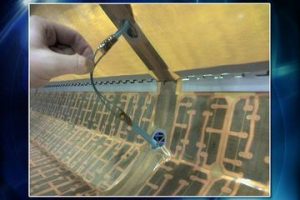
Peggy Whitson and Shuttle pilot George Zamka spent part of the next day making bracing straps from 12-gauge wire and 10-centimeter-long aluminum strips at each end. They wrapped Kapton tape around each strap as an insulator. Peggy Whitson described the final result as “cuff-links”. Each cuff-link had to be shaped precisely, so they watched a demonstration video starring astronaut Don Pettit that had been sent up to them and, afterwards, they had to change the length of one cuff-link by 3/8 inch. It took them six hours to make the five bracing straps. It wasn’t going to be perfect, but Peggy Whitson had grown up on a farm and was used to improvised fixes. As she put it, “You can fix just about anything with a number 2 wire and a pair of pliers.”
At the end of the day, Douglas Wheelock and Scott Parazynski camped out in Quest as part of procedures designed to prevent a case of “the bends” during the EVA. Parazynski was going to carry out the risky part of the repair job. The panel had 100 volts of electricity running through it with no way to turn it off. He was briefed on what areas of the solar array to avoid.
On November 3, Discovery’s Orbital Boom Sensor System (OBSS) was handed off from the Shuttle’s robotic arm to Canadarm2 to assist with repairs. Wheelock and Parazynski exited through Quest at 06:03 and Parazynski mounted the OBSS. Canadarm2 carried him in a wide art from the center of the ITS to an area 30 meters above the airlock and 50 meters to the port side of the station. He looked like a small dot to astronauts watching from inside the space station. Melroy, watching through binoculars, spotted a series of frayed deployment guide wires that looked like a “furball.” Ground controllers saw the same thing through Parazynski’s helmet camera. Melroy was understandably tense. She didn’t want to be the Shuttle Commander who lost a crew member to 100 volts of electricity.
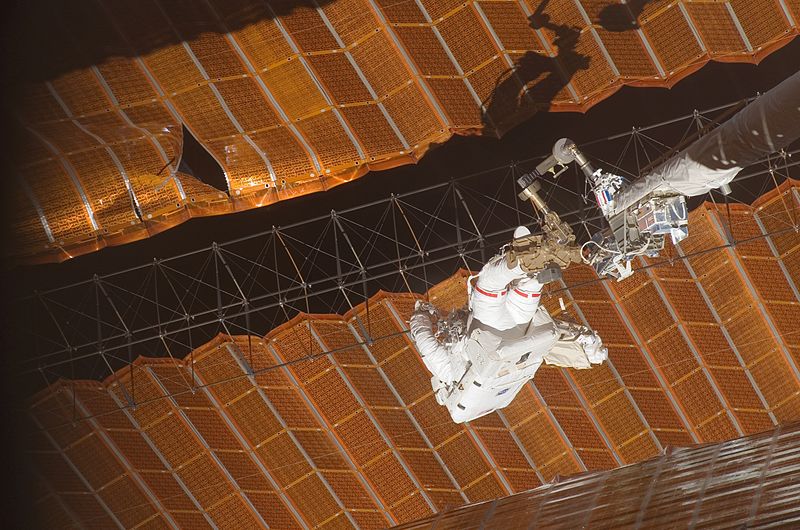
Parazynski cut a guide wire with an insulated tool. Wheelock remained at the base of the Solar Array Wing and used a pair of pliers to feed it through a take-up reel. Parazynski poked the five bracing straps through holes in the Solar Array Wing. This took some of the pressure off the damaged parts of the solar array. Peggy Whitson finished the deployment of the now-repaired Solar Array Wing, taking it a little bit at a time. Parazynski rode the OBSS back to Quest and the EVA ended with a duration of 7 hours and 19 minutes. It wasn’t quite a record-breaking EVA in terms of time, but Lead Station Flight Director Derek Hassman called it “One of the most satisfying days that I’ve ever had in Mission Control.”
The station was now nearly ready for the addition of more habitable modules. November 4 was primarily spent sharing congratulations on a spectacular job and making final transfers of cargo. Clayton Anderson admitted to mixed feelings about leaving the space station after five months. “Five months ago I was on my back preparing to launch and wondering what the heck I had gotten myself into. … Part of me is ready to go and part of me wants to stay.”
After an emotional farewell, the STS-120 crew returned to Discovery and closed the hatches for the final time. They undocked for the final time early in the morning of November 5. Melroy had requested a daytime landing. The weather gave the Space Shuttle a break and Discovery made a landing at the Kennedy Space Center at the first opportunity on November 7. NASA Administrator Michael Griffin described the mission as “NASA at its best.”
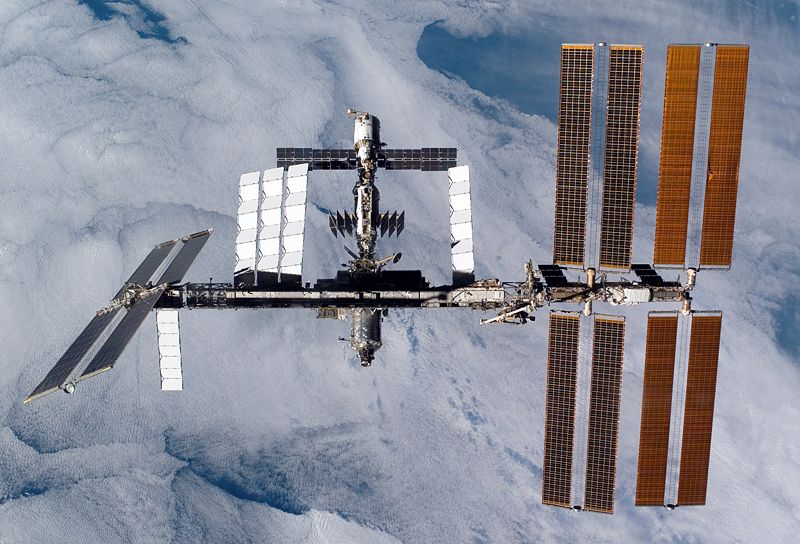
Space Shuttle Collectibles on eBay
[simple-rss feed=”http://rest.ebay.com/epn/v1/find/item.rss?keyword=Space+Shuttle+STS-120&categoryId1=1&sortOrder=BestMatch&programid=1&campaignid=5337337555&toolid=10039&listingType1=All&lgeo=1&feedType=rss” limit=5]


